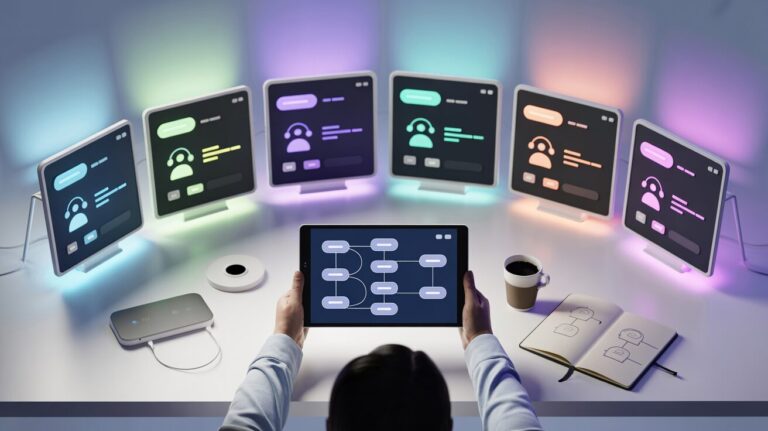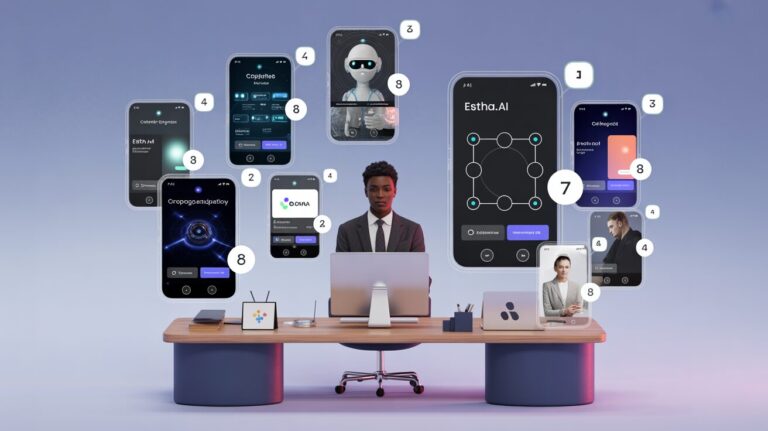Table Of Contents
In today’s rapidly evolving AI landscape, the ability to provide real-time data to GPT agents has become a game-changer for creating dynamic, responsive AI applications. Webhooks serve as the critical bridge that enables this real-time communication, allowing your AI agents to react to events as they happen rather than relying solely on pre-loaded information.
Whether you’re looking to build a customer service chatbot that accesses live inventory data, a financial advisor AI that incorporates real-time market changes, or a health monitoring system that responds to patient data updates, understanding how to stream data into GPT agents with webhooks is an essential skill. And the best part? With platforms like Estha, you don’t need extensive coding knowledge to implement these powerful capabilities.
This comprehensive guide will walk you through everything you need to know about connecting real-time data streams to GPT agents using webhooks. We’ll cover the fundamentals, step-by-step implementation processes, and show you how to leverage Estha’s no-code platform to build sophisticated AI applications that respond dynamically to real-world events and data changes.
Streaming Data into GPT Agents with Webhooks
A Complete Implementation Guide with Estha’s No-Code Platform
What Are Webhooks?
Webhooks are automated messages sent between applications when specific events occur. They use a “push” model, only sending data when triggered, making them ideal for real-time data streaming to GPT agents.
Why Use GPT Agents?
GPT agents are AI systems built on large language models configured for specific tasks. When connected to real-time data through webhooks, they transform from static knowledge bases into dynamic, responsive systems.
1
Key Benefits of Webhook Integration
Real-Time Responsiveness
AI agents provide answers based on the most current information available.
Contextual Awareness
GPT agents understand current context for more relevant interactions.
Automated Workflows
Process incoming data and initiate appropriate actions automatically.
Implementing Webhooks with Estha’s No-Code Platform
Create your GPT agent using Estha’s intuitive interface
Configure webhook endpoints in the Integrations section
Connect webhook data to your agent using drag-drop-link
Define how webhook data influences your agent’s behavior
2
Real-World Applications
Customer Support
Chatbots with real-time access to order status, inventory, and account information.
Content Creation
AI assistants that incorporate trending topics and analytics for relevant content.
Personalized Learning
Educational AI that adapts to student progress based on real-time performance data.
Key Takeaways
- No Coding Required: Estha’s platform makes webhook integration accessible to everyone, regardless of technical background.
- Real-Time Data: Transform static GPT agents into dynamic systems that respond to current events and information.
- Visual Configuration: Use Estha’s intuitive drag-drop-link interface to connect data sources and define agent behavior.
- Versatile Applications: Build sophisticated AI solutions for customer service, content creation, education, and workflow automation.
Start Building with Estha Today
Create custom GPT agents with real-time data integration in minutes — no coding required.
Understanding Webhooks and GPT Agents
Before diving into implementation, let’s establish a clear understanding of the core technologies we’re working with.
What Are Webhooks?
Webhooks are automated messages sent from one application to another when specific events occur. Unlike traditional APIs that require constant polling for updates, webhooks operate on a “push” model—they only send data when something happens. Think of webhooks as a notification system that alerts your application when events of interest take place.
For example, when a customer places an order on your e-commerce platform, a webhook can instantly notify your inventory management system to update stock levels. This event-driven approach is more efficient than having your inventory system repeatedly check for new orders.
Understanding GPT Agents
GPT agents are AI systems built on large language models (like GPT-4) that have been configured to perform specific tasks or functions. While the base GPT models are powerful, they become truly useful when customized as “agents” with defined purposes, access to external tools, and the ability to make decisions based on incoming information.
These agents can range from simple chatbots to complex AI assistants that can analyze documents, generate content, provide recommendations, or even execute workflows. What makes them particularly valuable is their ability to understand context, maintain conversation history, and adapt to new information—especially when that information arrives in real-time.
Why Stream Data to GPT Agents?
Connecting real-time data streams to GPT agents transforms them from static knowledge repositories into dynamic systems that can respond to changing conditions. Here are some compelling reasons to implement this capability:
Real-Time Responsiveness
When your GPT agent has access to real-time data, it can provide answers and take actions based on the most current information available. For customer-facing applications, this means more accurate responses and fewer frustrating experiences where AI provides outdated information.
Contextual Awareness
Streaming data enables your AI to understand the current context more completely. For instance, a weather-aware virtual assistant can proactively suggest umbrella reminders when rain is detected in the forecast for your area, rather than waiting for you to ask about the weather.
Automated Workflows
By combining webhooks with GPT agents, you can create sophisticated automated workflows. When specific events trigger webhooks, your AI can process that information and initiate appropriate actions—from sending notifications to updating databases or triggering other systems.
Setting Up Webhooks for Data Streaming
Now that we understand the value of connecting webhooks to GPT agents, let’s walk through the process of setting up this infrastructure.
Identifying Webhook Sources
The first step is identifying which data sources you want to connect to your GPT agent. Common webhook sources include:
- Payment processors (Stripe, PayPal)
- CRM systems (Salesforce, HubSpot)
- Email marketing platforms (Mailchimp, SendGrid)
- Project management tools (Asana, Trello)
- IoT devices and sensors
- Social media platforms
- Custom applications with webhook capabilities
Each source will have its own documentation for setting up webhooks, but the general process remains similar across platforms.
Creating Webhook Endpoints
For your GPT agent to receive webhook data, you need to create an endpoint—a URL that will accept and process incoming webhook requests. Traditionally, this would require:
- Setting up a server to receive HTTP requests
- Creating routes to handle different webhook types
- Implementing authentication to verify webhook sources
- Processing the payload and storing relevant data
- Formatting the data for consumption by your GPT agent
However, with no-code platforms like Estha, this process is dramatically simplified. Estha provides built-in webhook endpoints that can be configured without writing a single line of code—making this technology accessible to business users, content creators, and other professionals without technical backgrounds.
Implementing Webhooks with GPT Agents
Once your webhook infrastructure is in place, you need to connect it to your GPT agent and ensure the data is used effectively.
Data Processing and Transformation
Webhook payloads often contain more information than your GPT agent needs, or the data might be in a format that’s not immediately useful. Before feeding this data to your agent, you’ll typically need to:
1. Filter the payload to extract only relevant information
2. Transform the data into a format your GPT agent can effectively use
3. Enrich the data with additional context if necessary
4. Structure the input to match your agent’s expected format
With traditional development approaches, this would require writing custom processing logic. With Estha, you can use visual data transformation tools to prepare webhook data for your AI without coding.
Integrating with GPT Agent Prompts
The key to effective data streaming is properly integrating real-time information into your agent’s prompts. There are several approaches:
Context Insertion: Add the streaming data directly into the context window of your GPT agent, allowing it to reference this information when generating responses.
Prompt Engineering: Dynamically modify your agent’s instructions based on incoming data, steering its behavior in response to real-time events.
Tool Calls: Use webhooks to trigger function calling within more advanced GPT agents, enabling them to take specific actions when certain data arrives.
Memory Management: Update your agent’s persistent memory with streaming data, allowing it to reference this information across multiple user interactions.
Building Real-Time AI Applications with Estha
Estha’s no-code platform makes implementing webhook-powered GPT agents accessible to everyone, regardless of technical background. Here’s how to build real-time AI applications using Estha:
Creating Your GPT Agent in Estha
1. Log into your Estha account at https://studio.estha.ai/
2. Create a new AI application by selecting from the available templates or starting from scratch
3. Configure your agent’s personality, knowledge base, and behavior using Estha’s intuitive drag-drop-link interface
4. Define the primary functions your agent will perform (customer support, data analysis, content creation, etc.)
5. Test your base agent to ensure it responds appropriately to typical user queries
Setting Up Webhook Integration
1. Navigate to the Integrations section in your Estha project dashboard
2. Select “Webhook” from the available integration options
3. Configure your webhook endpoint – Estha will generate a unique URL for your application
4. Set up authentication to ensure only authorized sources can send data to your endpoint
5. Define the expected data structure for incoming webhooks
6. Create data transformation rules using Estha’s visual mapping tools
Connecting Webhooks to Your GPT Agent
1. Go to the Agent Builder interface in your Estha project
2. Create a data connection point by dragging the webhook data source into your agent’s configuration
3. Define how webhook data should influence your agent – whether it updates context, modifies instructions, or triggers specific responses
4. Set up conditional logic to determine how your agent responds to different types of webhook data
5. Configure error handling to ensure your agent degrades gracefully if webhook data is unavailable
Common Challenges and Solutions
While implementing webhook-powered GPT agents, you may encounter several challenges. Here’s how to address them:
Handling Rate Limits and Downtime
Webhook sources may have rate limits or experience occasional downtime. To mitigate these issues:
1. Implement queuing mechanisms to buffer incoming webhook data during high-volume periods
2. Create fallback behaviors for your GPT agent when real-time data isn’t available
3. Set up monitoring to alert you when webhook connections fail
4. Implement retry logic for failed webhook deliveries
Estha handles many of these concerns automatically, with built-in queuing and retry mechanisms that work without requiring custom code.
Security Considerations
Webhooks can pose security risks if not properly managed:
1. Always verify webhook sources using signatures, secret tokens, or IP filtering
2. Sanitize incoming data to prevent injection attacks
3. Implement rate limiting on your webhook endpoints to prevent DoS attacks
4. Use HTTPS for all webhook communications
5. Limit the permissions of systems processing webhook data
Estha’s platform includes built-in security features that handle authentication and data sanitization automatically, reducing the risk of security vulnerabilities.
Advanced Use Cases and Examples
Let’s explore some powerful applications of webhook-powered GPT agents that you can build with Estha:
Real-Time Customer Support Enhancement
Create a customer support chatbot that automatically accesses the latest product information, order status, and account details. When a customer inquires about their recent purchase, the agent receives real-time data via webhooks from your order management system, providing accurate shipping updates without transferring to a human agent.
Dynamic Content Creation
Build a content creation assistant that stays current with industry trends. Connect webhooks from news APIs, social media monitoring tools, and your company’s analytics platform. When your marketing team asks the agent to draft content, it incorporates the latest trending topics and performance data to create highly relevant material.
Personalized Learning Experiences
Develop an educational AI that adapts to student progress. Connect webhooks from your learning management system to track completion rates, quiz scores, and engagement metrics. The GPT agent then personalizes its tutoring approach based on each student’s current performance, focusing on areas where they need the most help.
Intelligent Process Automation
Create a workflow orchestrator that responds to business events. Connect webhooks from your business systems to notify your GPT agent when new leads are generated, when inventory levels change, or when service tickets are created. The agent can then initiate appropriate workflows, assign tasks to team members, and provide status updates to stakeholders.
Conclusion
Streaming data into GPT agents with webhooks represents a significant advancement in AI application development, enabling truly dynamic, responsive, and contextually aware AI systems. While traditionally this capability required extensive technical knowledge and custom development, platforms like Estha are democratizing access to these powerful techniques.
By leveraging Estha’s no-code approach, professionals across industries can now build sophisticated, real-time AI applications without writing a single line of code. The intuitive drag-drop-link interface makes it possible to connect data sources, configure GPT agents, and deploy powerful AI solutions in minutes rather than weeks or months.
As AI continues to evolve, the ability to stream real-time data to your intelligent agents will become increasingly important. Whether you’re building customer-facing applications, internal business tools, or specialized domain experts, the combination of webhooks and GPT agents provides the foundation for the next generation of AI solutions.
Ready to start building your own webhook-powered GPT agents? With Estha’s no-code platform, you can create sophisticated AI applications that leverage real-time data in just minutes. Our intuitive interface eliminates the technical barriers traditionally associated with AI development, making this powerful technology accessible to everyone—regardless of your coding experience.
From customer service chatbots and content creation assistants to educational tools and business process automation, the possibilities are virtually limitless. Join the growing community of professionals who are transforming their industries with custom AI applications built on Estha.
Transform Your Ideas into Powerful AI Applications
No coding required. Build your custom GPT agent with real-time data integration in minutes.



